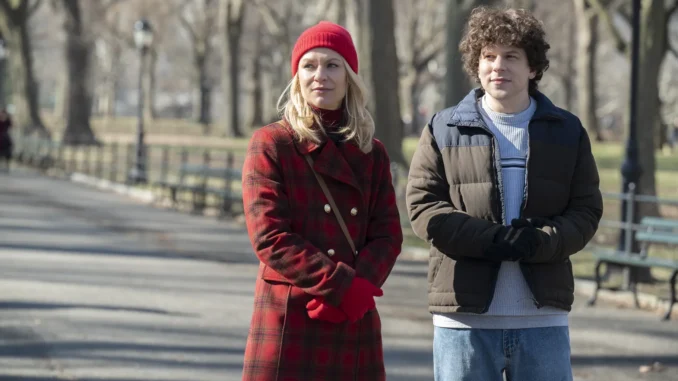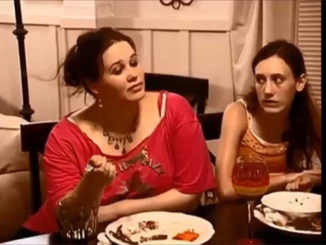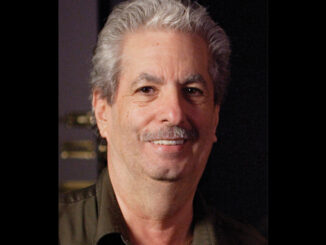
By Oliver Webb
Josh Beal, ACE, studied at ArtCenter College of Design in Pasadena with the goal of becoming a director, before happily venturing into a career in editing.
“Its claim to fame, as far as filmmaking goes, is that Michael Bay and Zak Snyder both went there,” he said. “You have to take editing classes, and so in that sense I’m trained, but I’m not one of those guys who went to like AFI specifically for editing.”
Beal cut three episodes of the FX miniseries “Fleishman Is in Trouble,” including the series finale. Based on Taffy Brodesser-Akner’s acclaimed novel, the series follows Toby Fleishman, a recently divorced 40 year-old who is tasked with balancing his hectic work and private live after the mysterious disappearance of his ex-wife.
CineMontage: How did you first get involved with “Fleishman”?
Josh Beal: I’d previously worked on a show called “Night Sky” with J.K. Simmons and Sissy Spacek, which was unfortunately short lived. That’s where I met directors Robert Pulcini and Shari Springer Berman, and they suggested me for “Fleishman.” I met with them and the creator of the show, Taffy Brodesser-Akner, and Jonathan Dayton and Valerie Faris, the other directorial team, and they decided to bring me on.
CineMontage: What were your initial conversations about the show?
Josh Beal: There was talk about what it wasn’t before there was talk about what it was. Taffy would often repeat that it’s not a show about divorce and it’s not a comedy. I don’t think they wanted anyone involved in the making of it to misconstrue it as wacky rom-com. The humor had to come out in the pain of the realities of the situations being depicted, through character for example. There was also discussion about inspiration from Woody Allen films from the era of “Manhattan” and “Hannah and Her Sisters.” The other thing that came up was subjectivity and point of view, because that played a big role in the story. There was a recognition that the editing was going to be pivotal on that front.
CineMontage: Did you have a close collaboration with the other editors, Jacquelyn Le and Jeffrey M. Werner?
Josh Beal: We weren’t in an office for this show, but we did make an attempt to compensate for that. We talked on the phone and we watched each other’s work. There was less discussion between the three of us than there might have been had we been sharing an office and having lunch together. They are tremendously talented and nice people and it felt like we were ultimately on the same page. There wasn’t the sort of initial template that was laid out that there sometimes is when you come onboard a show. In that sense, what collaboration we did have was really helpful. To have open communication and discuss what was going on in each of our rooms.

CineMontage: How did you approach the voice-over narrative elements of the show?
Josh Beal: The voice-over was seen as a potential concern quite early on and some of the directors thought how are we going to cover this visually? All the directors came up with their own ways of doing that which were unique to their respective episodes. To find interesting visual ways of telling the story that could then live underneath some voice-over. It was a bit of a balancing act to figure out how much voice-over. Taffy likes words and uses them really well, but at the end of the day, it’s a visual medium and you don’t want to just have an illustrated audio book. You don’t want to shortchange the fun of hearing Lizzy Caplan interpret the narration because she’s wonderful and the device is central to the storytelling. I think that Sarah Timberman and her partner Susannah Grant who produced this were the ones that suggested Taffy also write the script. That decision was likely critical because her voice is singular and she knows what she’s saying better than anyone. Also, with Taffy, you’d be sitting there needing a change and she’d just do it on the spot, which was both impressive and efficient.
CineMontage: The show revolves around the build up to Rachel’s disappearance. Could you discuss your approach to the use of flashbacks and ensuring the flow of the episodes?
Josh Beal: I love the way the flashbacks are integrated in the show. I feel they were most successful when they were really folded into the whole creation of a scene. Episode four, for example, Bob and Shari designed what looked like a one-shot movement throughout Rachel’s apartment when Toby goes into it. As we are passing through, present Toby is seeing these moments in time that he experienced when he lived in that apartment. As the camera moves through it, he is sharing the space with his own memories. That’s a very elegant way of doing flashbacks. It is reminiscent of some Woody Allen films, such as “Annie Hall,” where the characters would go and share the space with the past and they might comment on it. Taffy and the directors designed things that way, but there are still editing details within that. You are still choosing takes of what pieces are going to get composited into the finished move and you are adjusting timing because the flow and the pacing of those moments needs to be right. There’s a lot of tailoring and hiding your cuts and visual effects is key with making all of it ultimately work.
Some flashbacks were a little more straightforward, such as a simple cut to the past or a montage of images. One example is in episode eight, with Libby at the climax of the episode and her turning point, which we called the “and now” sequence where there is this refrain of “and now” in the narration and popping through clips of Libby’s life, of what we have seen. I think it was Bob who came up with the great idea of juxtaposing a little detail of Toby and Libby, Toby will help her up when she’s seated and she’ll do this little bow. They do that several times throughout the show and you can see that that’s been their schtick, which they’ve done for years with each other. When you’re cutting a montage, you’re looking for relationships between images that evoke a feeling and I think that was effective. Also, Caroline Shaw’s brilliant score is adding another unifying element.
CineMontage: It’s interesting to see a cast, well-known for roles they played in their teens, now playing these middle-aged characters. What was it like working with such a cast?
Josh Beal: It was nothing but a joy. They are just a tremendous group of actors. That was pretty much Taffy’s dream cast that she was able to get together. It doesn’t always work out with schedules or whatever and getting the actors you want, but this time it did.
CineMontage: What was your favorite sequence to put together?
Josh Beal: I’ve always loved cutting arguments between couples, or arguments in general. I like dialogue when it’s good and the show is full of that, and the conflict and drama is just there. It’s a fight scene, but it’s verbal and emotional. I really enjoy when you have two actors that are really in the moment and doing a great job with their performance. I love putting those fireworks together and protecting their best work. The other one is a long scene in episode two, when Toby, Libby and Seth are sitting in Central Park. Toby realizes that something might have happened to Rachel and he’s trying to push that out of his mind. Similarly, to arguments, I like the three of them interacting and all the little details of little asides and adds. They had a rapport that felt like a natural vibe between friends and that banter is largely about the rhythm of those exchanges. That’s all surface and then there is the subtext of what’s happening internally with Toby. I tried to cut that scene a lot shorter and I was probably ultimately wrong about that. It was important to Taffy that these conversations feel real and take a natural course. She didn’t want hyper-efficient “movie” conversations.
CineMontage: It brilliantly ties together in the final episode. How important was it to keep in flow with the novel’s structure?
Josh Beal: It’s got to be one of the most faithful adaptations of a book. My wife first read the book and she really liked it and told me about it. A year or two later I ended up working on it and so of course, I read it. I read it before I had the interview and I was so excited about it. My wife saw the series and although she really liked the book, she felt that something was brought out of the material even more in the series. It was a different element that was illuminated by seeing it as a show. I’d follow Taffy to the ends of the Earth at this point. I’m sure even Taffy’s failures would be more interesting and fun than many people’s successes.





